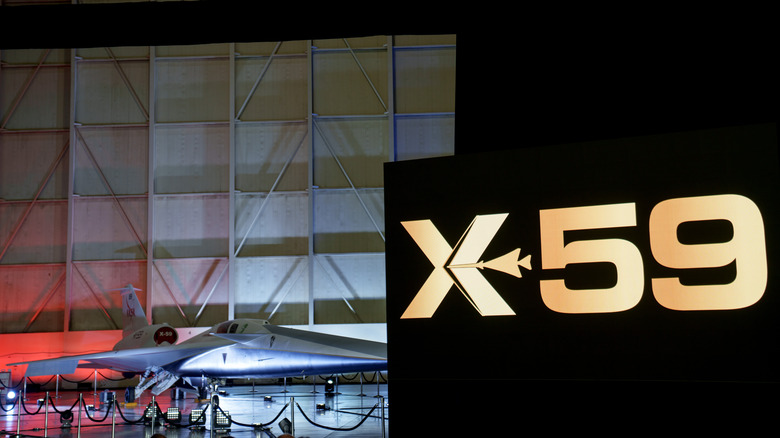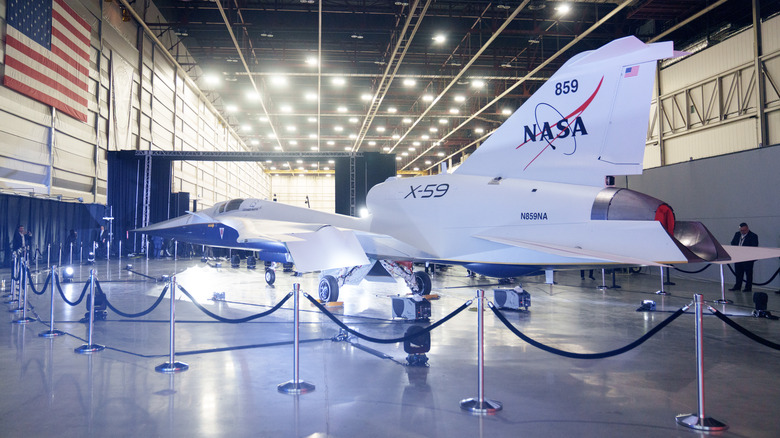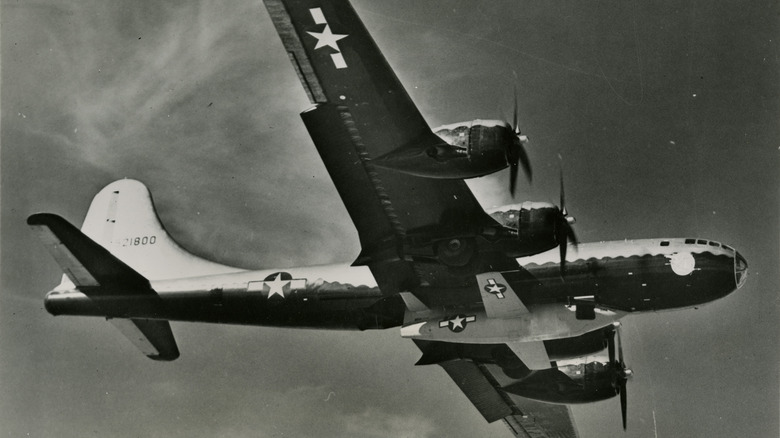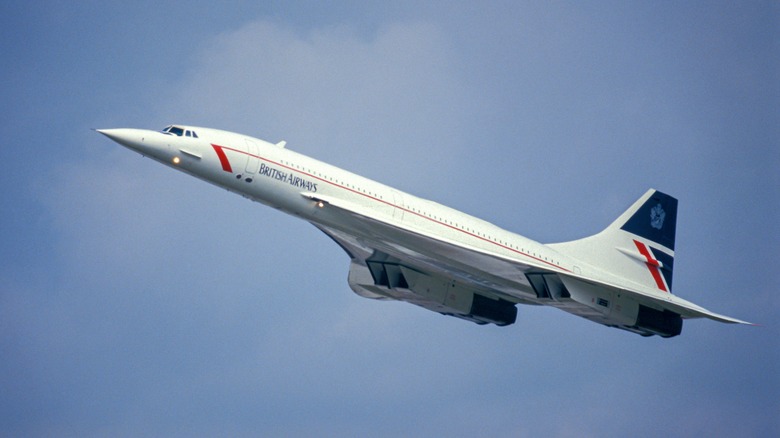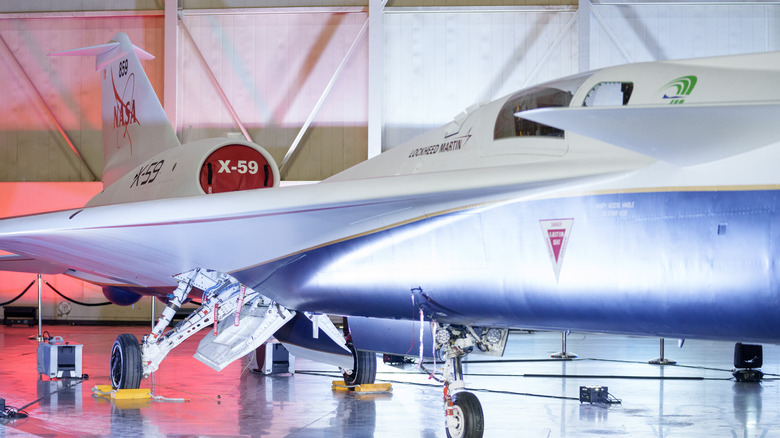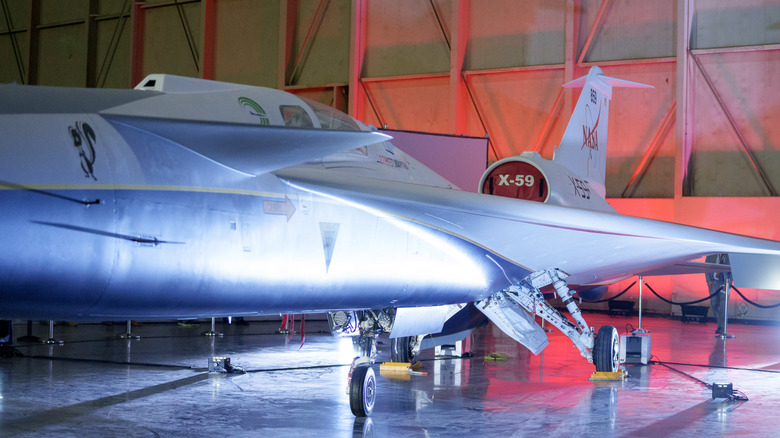Everything To Know About NASA's New X-59 Supersonic Aircraft
On January 12, 2024, NASA and Lockheed Martin Skunk Works debuted the X-59 quiet supersonic aircraft in Palmdale, California. In line with NASA's ongoing Quesst mission, the success of the X-59's launch brings us one step closer to regaining commercial supersonic flight.
The unveiling ceremony was live-streamed on several NASA platforms, including NASA Television, the NASA app, NASA+, YouTube, and its website. Among the speakers at the event were NASA Deputy Administrator Pam Melroy, NASA Associate Administrator James Free, and representatives from Skunk Works and Lockheed Martin.
In an effort to engage the public, NASA also created a virtual boarding pass system, wherein ordinary people could sign up to the historic launch and get a virtual boarding pass. Afterwards, these names would be downloaded into a storage device, carried by the pilot into the aircraft, and logged into their logbooks.
But what makes supersonic flights so special, and how does the X-59's launch really impact air travel for the ordinary person?
What are supersonic flights?
Supersonic flights travel faster than the speed of sound. Although the speed of sound varies across materials, NASA's Glenn Research Center shares that on a standard day at sea level under static conditions, the speed of sound is about 761 mph or 1,100 ft/second.
With supersonic flights, passengers can reach destinations significantly faster than with average aircraft. However, supersonic aircraft also carry several disadvantages, particularly when it comes to sound. Referred to as the "Sonic Boom," NASA defines this as "the thunder-like noise a person on the ground hears when an aircraft or other type of aerospace vehicle flies overhead faster than the speed of sound or supersonic."
Despite NASA's claims that most instances wherein the sonic boom can be heard are usually too weak to cause physical injury to people, as well as most normal buildings, the Federal Aviation Administration (FAA) issued a ban on supersonic flights over the U.S. by civilian aircraft, which became effective in April of 1973.
In a 1977 unclassified document by the Defense Technical Information Center (DTIC), it detailed several citations regarding damages caused by the sonic boom, specifically environmental and noise pollution.
Here's a short history of supersonic aircraft, how one commercial aircraft received special permission to fly, and why the X-59 could still change the game.
A history of supersonic flights
In October 1947, the Bell X-1 rocket-powered plane became the first recorded aircraft to have flown faster than the speed of sound, which clocked in at Mach 1.06. Piloted by Major Charles E. Yeager of the U.S. Air Force, it broke the sound barrier at 1,066 km (662 miles) per hour and reached a top speed of 1,126 km (700 miles) per hour.
A year later, in March 1948, the National Air and Space Museum noted that the Bell X-1 reached a speed of 1,540 kilometers (957 miles) per hour at an altitude of 21,900 meters (71,900 feet), which was the highest velocity and altitude that a manned airplane was able to reach at the time.
Since then, supersonic flight capabilities have been a staple for military aircraft, such as supersonic bombers and multirole jets like the F-35 Joint Strike Fighter. In fact, it even remains a critical component for various newly developed indigenous aircraft, like Turkey's TAI Hürjet and India's HAL Tejas.
However, commercial attempts at supersonic flight have been less than satisfactory, with only one airplane making the cut: the Concorde.
Concorde: the first supersonic passenger plane
Built as a joint venture between the United Kingdom and France, the Concorde was a supersonic passenger-carrying commercial plane, which had its maiden flight in March of 1969.
In 1977, the Journal of Air Law and Commerce shared that the Concorde's development was rife with problems, including engineering and economic difficulties. Despite international controversy, the FAA granted the Concorde special consideration for its noise pollution.
According to British Airways, the Concorde's fastest transatlantic crossing was in 1996, wherein it completed a New York-to-London flight in 2 hours, 52 minutes, and 59 seconds. In comparison, the same route takes around eight hours and 10 minutes in 2024.
Unfortunately, in 2000, an Air France Concorde plane crashed shortly after takeoff, resulting in the loss of 109 passengers and crew. This incident led to the grounding of the Concorde and the introduction of additional safety measures.
When the Concorde resumed flights a year later, it coincidentally happened on the same day as the devastating 9/11 terror attacks. Although it was not the plane used in the attacks, it became a victim to the event's impact on the airline industry. After only 50,000 flights, 2.5 million passengers, and 27 years of service, British Airways conducted the Concorde's final commercial flight in October 2023.
Since then, supersonic commercial air travel has been on the backseat. But with the success of the X-59, we may be getting our second chance, for a couple of reasons.
The X-59 and the Quesst mission
Designed to reduce the sonic "boom" experience to a "thump," the X-59 (also known as the Low Boom Flight Demonstrator) is referred to by NASA as the "centerpiece of the agency's Quesst mission."
NASA's Quiet Supersonic Technology (QueSST) mission is split into two key parts: design and build the X-59 and gather data that can be submitted to U.S. and international regulators. The mission shares three distinct phases: co-development of the X-59 design with the designated contractor, performance of validation flights, and a community response overflight study.
Although it started development in 2016, NASA awarded Lockheed Martin the Low-Boom Flight Demonstration contract, valued at $247.5 million, in 2018 (via PR Newswire). To make the reduced noise possible, NASA Deputy Administrator Pam Melroy shares some key engineering decisions, such as the long, distinct nose, setting the cockpit halfway down, and no forward-facing window.
In November 2022, NASA reported the installation of an General Electric Aviation F414-GE-100 engine on the X-59, which was 13ft long and produced 22,000 pounds of propulsion energy. NASA claims that it could help the X-59 reach up to Mach 1.4 speed and altitudes of around 55,000 ft.
According to Lockheed Martin, the data collected in testing will be used to help lift the ban on commercial supersonic travel over land by providing regulators with information required to establish commercial supersonic noise standards. In 2018, NASA reportedly paid $25 for participating survey respondents during its supersonic flight tests in Galveston, Texas.
The future of supersonic commercial air travel
If community feedback from the X-59's testing is positive, the next big hurdle for NASA and Lockheed Martin will be lobbying to lift the ban. However, their attempts to engage audiences via live streams and virtual boarding passes could potentially help sway public opinion in their favor. On the other hand, several other U.S. companies have also met milestones in their quest for supersonic commercial air travel: Boom Supersonic, Aerion Supersonic, and Spike Aerospace.
Boom Supersonic, an aviation startup attempting to build the world's fastest airline, claims that its XB-1 demonstrator jet has already undergone extensive ground testing. In 2017, Boom Supersonic announced a strategic partnership with Japan Airlines, wherein JAL made an investment of $10 million. By 2022, Boom Supersonic had also secured orders from American Airlines and United Airlines. With a recent investment from the NEOM Investment Fund (NIF), Boom Supersonic's total funding has exceeded $700 million. In its partnership announcement with United Airlines, the first U.S. airline to sign a purchase agreement, it shares that the net-zero carbon aircraft will fly on 100% sustainable aviation fuel (SAF) and carry passengers by 2029.
On the other hand, Forbes reported that Aerion Supersonic had ceased operations in 2021. Despite investments from industry giants like Boeing, Aerion announced that it was unable to raise enough capital requirements to go into production. Although Spike Aerospace is still continuing development for its S-512 supersonic luxury jet, which it claims could potentially fly at up to Mach 1.6.
